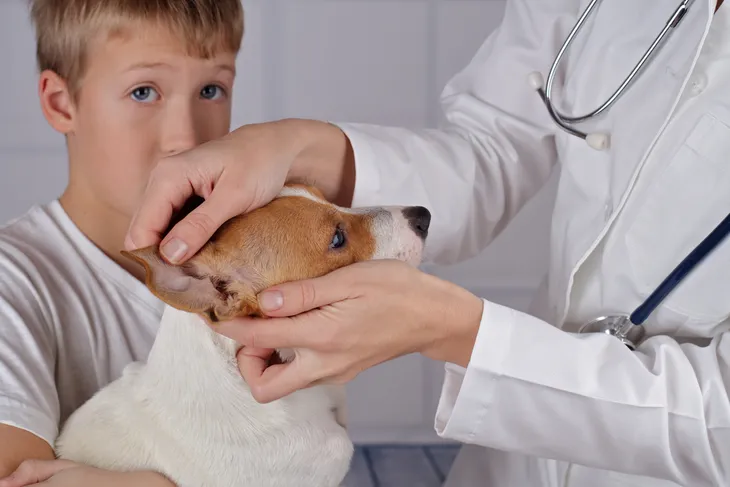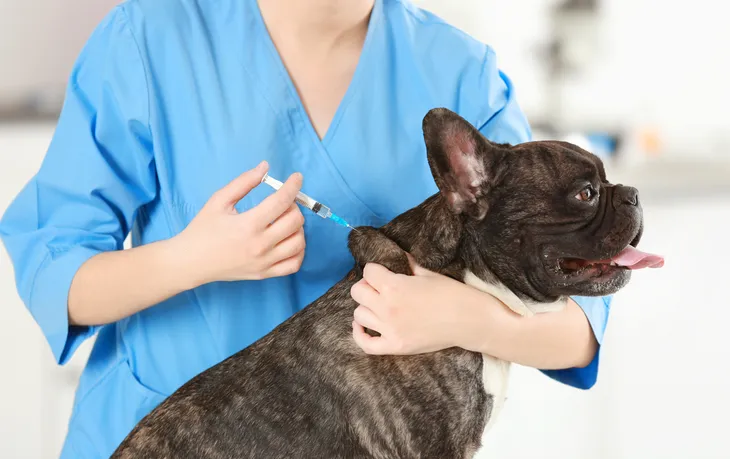Most pet guardians have been warned about tapeworms. These parasites are fairly common in domesticated animals, and take hold in the pet’s intestines. There are many different varieties of tapeworms that affect dogs, but the most common type is found in fleas, and they enter the dog’s body after it swallows an infected insect.
Tapeworms don’t usually cause serious health problems in dogs, but they can grow to relatively large sizes and spread through your pet’s intestines. As with most illnesses, prevention is the best management strategy, but given the commonness of tapeworm infections, it’s also a good idea to recognize the symptoms and understand the various treatment options that are available.
Symptoms of Tapeworms in Dogs
These are the six most common symptoms of tapeworms in dogs (note: treatment options are listed after the 6 symptoms below):
Symptom: Visible Worm Segments in Dog’s Bedding
Adult tapeworms are white worms with flat bodies that usually grow to lengths of 4 to 8 inches. They are made up of individual segments, and while it is very unlikely that you will encounter a full adult tapeworm, you may observe some of the segments that have detached from the worm’s body. In pet beds, these segments will usually be alive and squirming around.
If you spot narrow, flat, white segments of an organism in your dog’s bedding, chances are good that they came from an adult tapeworm that has infected your pet.
Symptom: Traces of Tapeworm Segments in Dog’s Fur
Your dog’s bedding is not the only place to look for evidence of tapeworm segments. Since these worm segments pass through your dog’s intestines and are eliminated from its body, they can get stuck to the fur around your dog’s anus. Checking in this area can confirm the presence of tapeworms if you have already seen worm segments in your dog’s bed. It’s also a good idea to periodically examine your dog’s rear end if you have an active pet that enjoys being outdoors.
Segments that are stuck to your dog’s fur are likely to be dead rather than alive. Dead tapeworm segments are yellow and hardened rather than white.
Symptom: Parasites in Dog’s Bowel Movements
Very few pet owners will respond with enthusiasm if you ask them to probe around in their pet’s poop, but if you suspect your dog may have a tapeworm infection, it’s one of the best places to look. In some cases, tapeworm segments won’t be found in your dog’s bed and they won’t be stuck to your dog’s fur, but they will be visible in your pet’s bowel movements.
If you see small white parasites squirming around in your dog’s waste after it has taken a number-two, tapeworms are almost certainly the culprit.
Symptom: Unusual Behavior
Tapeworms can cause irritation, and as such, your dog may start to display some unusual behavior that indicates their presence. The most common example is scooting, in which your dog plants its rear end on the floor and dashes across the room. This is done to relieve itching. In other cases, your dog may take to licking its anus excessively in an effort to relieve its discomfort.
Scooting and excessive licking are both abnormal in healthy, well-adjusted dogs. If your dog displays such behavior and has no previous history of doing so, you may have a tapeworm infection on your hands.
Symptom: Vomiting
Tapeworms attach themselves to your dog’s intestines, gripping and clawing the sides of intestinal tubes as they feed on partially digested food. In some cases, segments can detach and work their way up into your dog’s stomach. This can result in vomiting.
If there’s one thing less appealing than probing your dog’s poop for evidence of tapeworms, it’s sifting through vomit looking for parasites. Yet, this is what you should do if your dog starts throwing up, especially if you’ve noticed other symptoms of tapeworms. Welcome to the wonderful world of pet ownership!
Symptom: Weight Loss
Tapeworms are parasites, and by definition, parasites survive by feeding off their hosts. If your dog has a serious tapeworm infection, the parasite will steal a lot of the food your pet eats, effectively preventing your dog from nourishing itself. In such cases, chances are good that you’ll notice at least one of the previously mentioned symptoms. If these symptoms are accompanied by weight loss even though your dog is eating as it normally does, tapeworms are the probable cause.
Treatment of Tapeworms in Dogs
If there’s any good news about tapeworms, it’s that they can be treated fairly easily with a range of widely accessible and relatively inexpensive interventions.
Treatment: Deworming Tablets
Deworming drugs are the usual treatment for tapeworms. These drugs attack the bodies of the tapeworm parasites, dissolving them so they die inside your dog’s body without harming your dog. Because these medicines physically melt away the tapeworms, you will not see the remains of the parasites in your dog’s bowel movements (or vomit) after the treatment has run its course.
One of the most common ways to administer deworming drugs is via tablets, which your dog eats and swallows like you would with a chewable pill.
Treatment: Deworming Shots
Some dogs have an aversion to the edible tablets that contain deworming drugs, and if your pet is reluctant to take them, you can instead opt to have the medicine delivered via an injection. Depending on your dog’s health and the suspected size of the tapeworm, you may be offered a range of prescription veterinary medicines to treat the infection. Talk over the various merits and drawbacks of each option with your vet if you have questions about how they work.
Treatment: Flea Sprays, Powders, and Collars
As mentioned, prevention is the best treatment, so whether your dog is just getting over a case of tapeworms or is lucky enough never to have been infected, it’s always a good idea to institute a parasite control plan.
Repelling the fleas that carry tapeworms is a very effective way to make sure your dog never ingests one in the first place. Flea sprays, powders, and specially manufactured flea collars are all affordable and effective options.
Treatment: Oral Medication
Oral medications, which are usually taken once a month, can also be an effective line of defense against tapeworms, heartworms, and other parasites that commonly affect pets. These medicines work by delivering an effective dose of drugs that will kill any tapeworms that may have recently infected your dog. They have excellent safety profiles, and they are similar to the drugs used to eliminate more advanced tapeworm infections. Talk to your vet about your pet’s habits to determine the preventative oral medication that will offer the best level of protection.
Treatment: Topical Treatments
Topical liquid treatments and specially formulated pet shampoos are another option for eliminating and repelling the fleas that carry common tapeworms. There are many different products on the market, some of which are specially formulated for puppies and younger dogs. Others favor natural rather than synthetic and chemical ingredients. Discuss the available options with a knowledgeable, neutral professional before making a purchase if you’re unsure about a given product’s relative merits.
Preventative Treatment: Look After Your Pet
Finally, you can help prevent tapeworms by keeping your dog from roaming free or running unsupervised through outdoor areas where it is likely to encounter fleas. Dogs can also catch tapeworms and other parasites from other dogs, so be wary of pet-to-pet contact with animals that may be carrying infected insects. Solid waste also attracts fleas, so be sure to clean up after your pet at home and do your part to help keep bugs at bay by doing the same in parks and other public places.















